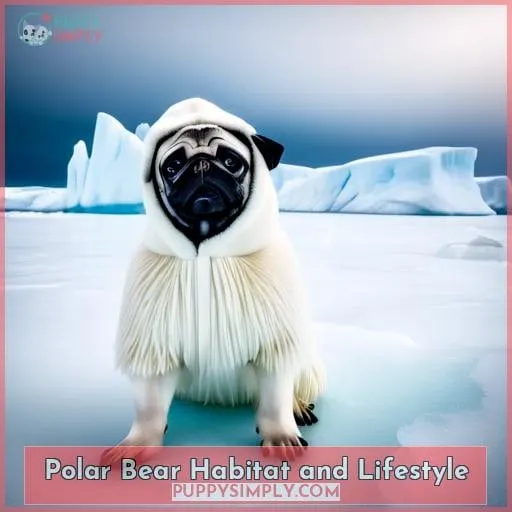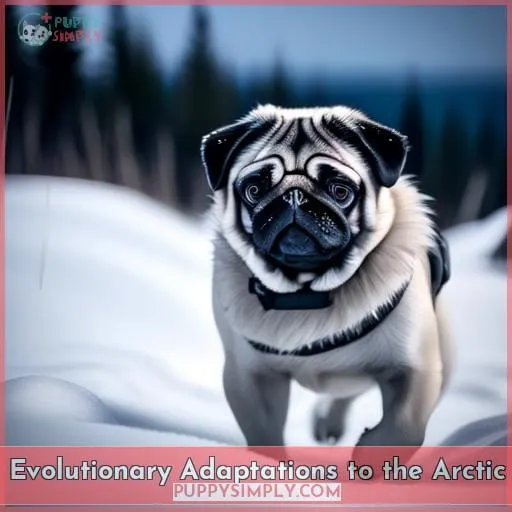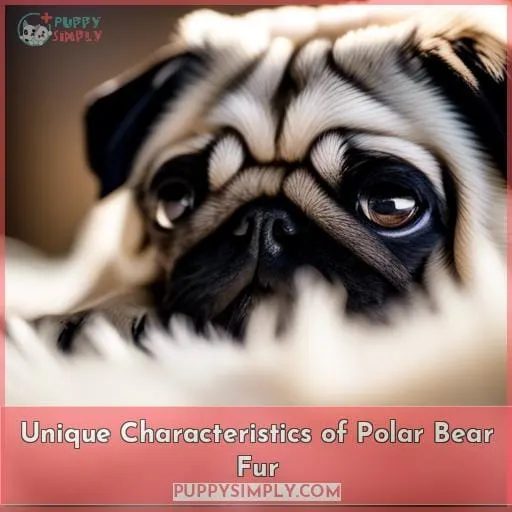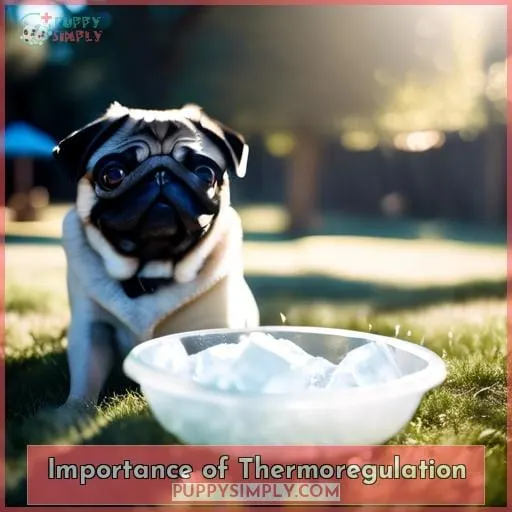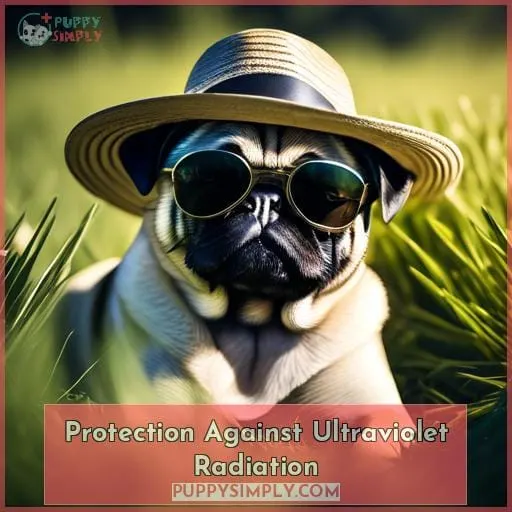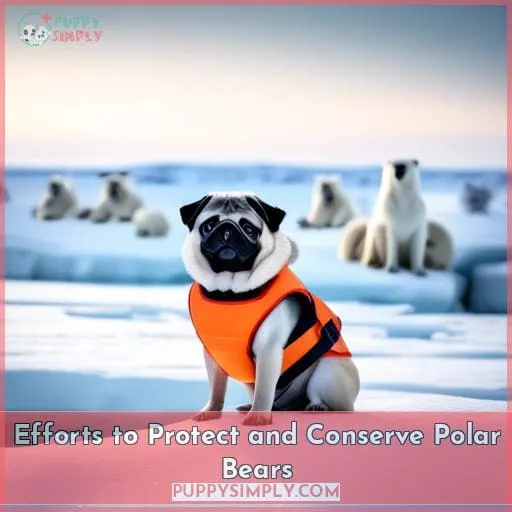This site is supported by our readers. We may earn a commission, at no cost to you, if you purchase through links.
 Imagine a furball of happiness, eager to lend a helping paw.
Imagine a furball of happiness, eager to lend a helping paw.
Pugs, with their affectionate nature and cheerful disposition, have the potential to be remarkable service dogs.
Let’s explore their unique qualities and suitability for various service roles, considering their temperament, training requirements, and health factors.
Discover how these small, sturdy companions can make a big difference in the lives of those they serve.
Table Of Contents
- Key Takeaways
- Polar Bear Habitat and Lifestyle
- Evolutionary Adaptations to the Arctic
- Unique Characteristics of Polar Bear Fur
- Importance of Thermoregulation
- Camouflage for Hunting and Survival
- Protection Against Ultraviolet Radiation
- Sensory and Communication Roles of Fur
- Environmental Challenges and Adaptability
- Winter Covering and Ecosystem Interactions
- Efforts to Protect and Conserve Polar Bears
- Pug Temperament and Suitability as Service Dogs
- Training Requirements for Pugs
- Potential Service Roles for Pugs
- Health and Physical Considerations
- Certification and Legal Aspects of Service Dogs
- Frequently Asked Questions (FAQs)
- Can pugs be trained to perform specific tasks like retrieving items or providing emotional support?
- What are some common challenges faced when training pugs as service dogs?
- Are there specific health conditions or physical limitations that might disqualify a pug from becoming a service dog?
- What are the legal requirements and certification processes involved in recognizing a pug as a legitimate service dog?
- How can pugs contribute to improving the quality of life for individuals with disabilities, and what unique benefits do they offer as service dogs?
- Conclusion
Key Takeaways
- Pugs’ friendly and gentle nature makes them suitable for service work, particularly in elderly assistance, therapy, and children’s therapy.
- Pugs require specialized training, temperament assessment, obedience classes, and socialization to become service dogs.
- Pugs can provide emotional support, companionship, and assistance in healthcare settings, assisting with mobility tasks, signaling for assistance, and fetching medication.
- While pugs can be service dogs, their small size and potential health issues may limit their ability to perform certain tasks, and legal requirements vary by location.
Polar Bear Habitat and Lifestyle
Your polar bear’s habitat is the Arctic ice.
It’s adapted to survive in this harsh environment.
Its home is a vast and ever-changing landscape of ice floes, glaciers, and frozen seas.
As a keystone species, its survival is crucial for the Arctic ecosystem.
You’re fascinated by their resilience and adaptability.
You want to learn more about how they thrive in such extreme conditions.
Understanding polar bear habitat and lifestyle is essential for effective wildlife management and conservation strategies.
By studying their ice dynamics, feeding habits, and social behaviors, scientists are gaining valuable insights into the impacts of climate change and human activities on Arctic ecology.
Your passion for these majestic creatures fuels your desire to contribute to their preservation.
Evolutionary Adaptations to the Arctic
Let’s consider the polar bear’s fascinating journey of adaptation to the Arctic.
Over time, they’ve diverged from their brown bear ancestors, developing unique traits that help them thrive in the harsh, icy conditions.
Their thick fur, specialized paws, and keen sense of smell are just a few examples of how they’ve adapted to their frigid home.
Adaptation to Arctic Environment
Continuing from their genetic divergence from brown bears, you’ll now explore polar bears’ remarkable adaptation to their Arctic environment.
Imagine their survival strategies, honed over centuries in the icy wilderness. They’ve mastered thermoregulation, enduring extreme cold and conserving energy.
Their hunting techniques are a marvel, from stealthily stalking seals to using sea ice as a hunting platform.
Their physiological adjustments, such as thick fur and blubber, offer protection from the elements.
Their ecological interactions are intricate, shaping the Arctic ecosystem.
Polar bears are a testament to nature’s resilience and the wonders of evolution.
Genetic Divergence From Brown Bears
Through a process of natural selection, polar bears have diverged genetically from brown bears, adapting remarkably to their Arctic environment.
Comparative genomics studies reveal their genetic uniqueness, highlighting the evolutionary adaptations that have enabled them to survive in these extreme conditions.
These adaptations demonstrate the remarkable resilience of life, showcasing nature’s ability to sculpt new species through speciation events.
Understanding these genetic differences helps us appreciate the delicate balance of the Arctic ecosystem and the importance of preserving these magnificent creatures.
Unique Characteristics of Polar Bear Fur
Let’s take a closer look at the structural coloration, keratin and hollow hair shafts, and transparency and light scattering of polar bear fur.
These unique features give polar bears their iconic white fur, which helps them camouflage in their snowy habitat and stay warm in freezing temperatures.
Structural Coloration
Witness the remarkable structural coloration of the polar bear’s fur, a testament to nature’s artistry and ingenuity.
Its fur isn’t naturally white; instead, it’s a translucent marvel, devoid of natural pigments. This fascinating adaptation plays a crucial role in their survival, allowing them to blend seamlessly with the icy landscapes they call home.
Explore the intricate structural variations that create optical illusions, helping polar bears camouflage themselves effortlessly.
Discover the biological function and ecological significance of this unique characteristic.
Keratin and Hollow Hair Shafts
Polar bears’ fur is composed of keratin and features hollow hair shafts.
This composition gives their fur structural strength, allowing them to withstand the harsh Arctic conditions.
The hollow shafts provide excellent insulation properties, trapping air and helping them retain body heat.
Genetic variations in their fur’s composition contribute to their exceptional thermal regulation abilities.
Their fur is a testament to nature’s intricate design, serving as a protective shield against the extreme cold they call home.
Transparency and Light Scattering
With their transparent hollow hair shafts, you’ll be astounded at how polar bears’ fur effectively scatters light and insulates them in their frigid Arctic home.
- The fur’s low refractive index minimizes light absorption, allowing more heat to reach the bear’s skin.
- Air pockets within the hollow shafts act as natural insulators, trapping heat and preventing heat loss.
- Light scattering reduces glare and enhances camouflage, aiding the polar bear in hunting and evading predators.
- The transparency mechanisms in the fur also provide UV protection, safeguarding the bear’s skin from harmful solar radiation.
Importance of Thermoregulation
Thermoregulation, a crucial aspect of your Pug’s well-being, is directly influenced by their fur.
Its dense and insulating properties, coupled with your Pug’s natural regulatory mechanisms, help maintain a stable body temperature.
Their fur acts as a barrier, preventing heat loss in cold environments and minimizing heat absorption in warmer climates.
| Regulatory Mechanisms | Body Insulation | Heat Exchange |
|---|---|---|
| Vasodilation and vasoconstriction | Trapping warm air near the skin | Convection, conduction, and radiation |
| Panting | Thick undercoat for added warmth | Evaporative cooling |
| Behavioral adaptations | Seasonal shedding | Shivering |
Your Pug’s fur also plays a role in heat exchange. Its ability to wick away moisture helps prevent overheating during exercise or in hot weather.
Additionally, behavioral adaptations, such as seeking shade or finding cool surfaces to lie on, help your Pug regulate their body temperature.
Environmental factors, including temperature, humidity, and wind, also influence your Pug’s thermoregulatory needs.
Camouflage for Hunting and Survival
From aiding thermoregulation, your polar bear’s fur also acts as a camouflage, helping it blend into its icy surroundings during hunts and while evading predators.
Its fur’s color, a combination of white and cream, works wonders in the Arctic’s snowy landscapes, helping it blend seamlessly with the ice and snow.
This camouflage is crucial for polar bears as it allows them to stalk their prey, primarily seals, without being detected.
Additionally, it helps them avoid becoming prey themselves, blending in with their surroundings when resting or sleeping.
Their fur’s camouflage is a vital survival strategy in the harsh Arctic environment, where hunting and survival are constant challenges.
Protection Against Ultraviolet Radiation
As you venture deeper into the fascinating world of polar bears, let’s shift our focus to their remarkable adaptation for protection against ultraviolet (UV) radiation.
Living in the harsh Arctic environment means contending with intense sunlight, and polar bears have evolved strategies to safeguard themselves from harmful UV rays.
Their fur, a marvel of evolutionary design, plays a crucial role in this protection.
Within their fur, polar bears possess a unique distribution of melanin, the pigment responsible for absorbing UV radiation. This strategic placement shields their skin from sunburn, a common affliction among humans exposed to excessive sunlight.
Additionally, the color variations observed in polar bear fur, from pure white to yellowish hues, contribute to their UV protection. Lighter fur reflects more sunlight, reducing heat absorption and minimizing the risk of sunburn.
Sensory and Communication Roles of Fur
Your polar bear’s fur also plays a crucial role in sensory perception and communication.
Picture this:
-
Sensory Hairs:
Polar bears possess specialized sensory hairs on their faces and paws, allowing them to detect slight changes in air currents, vibrations, and even the faintest of scents. It’s like having built-in super-sensitive whiskers!
-
Communication Signals:
Their fur conveys communication signals to other bears. Different postures and movements of the fur can indicate aggression, submission, or a desire to mate.
-
Pheromone Detection:
The fur acts as a pheromone detector, helping polar bears identify individuals, track prey, and establish their territory. Think of it as their own unique scent language.
-
Emotional Expression:
The position and movement of the fur can express emotions. A relaxed bear might have a smooth, sleek coat, while a stressed or anxious bear might have a ruffled, bristled appearance.
Environmental Challenges and Adaptability
You’ll want to consider the potential impact of climate change and how it might threaten their natural habitat.
As well as their adaptability to new environments and their capacity to thrive in challenging conditions.
These aspects are essential to evaluate when determining the suitability of pugs as service dogs.
Impact of Climate Change
- Polar bears’ unique fur adaptations are threatened by climate change, causing sea ice loss and disrupting their hunting and survival patterns.
The melting sea ice reduces their access to prey, forcing them to travel farther and expend more energy.
You can help protect these majestic creatures by:
- Supporting conservation efforts
- Reducing your carbon footprint
- Advocating for policies that mitigate climate change
Your actions can make a difference in the fight to preserve this iconic species.
Threats to Their Natural Habitat
While climate change dramatically affects their habitat, you’ll also discover threats to polar bears’ natural habitat from pollution, oil spills, and habitat loss.
These threats disrupt their hunting techniques, migratory patterns, and population estimates.
Oil exploration and habitat destruction further endanger these majestic creatures, leaving them vulnerable and struggling to survive.
Let’s explore how we can protect their natural habitat and ensure their survival.
Winter Covering and Ecosystem Interactions
As we delve deeper into the remarkable world of polar bears, let’s explore their winter covering and its intricate relationship with the ecosystem.
Their thick, white fur coat isn’t just a fashion statement; it’s a marvel of adaptation that keeps them warm in the frigid Arctic temperatures. Imagine yourself bundled up in a cozy blanket of fur, braving the icy winds. That’s what it’s like for polar bears.
- Their dense fur traps a layer of air, providing insulation and warmth.
- A thick blubber layer beneath their skin serves as an extra layer of protection against the cold.
- During winter, some polar bears exhibit hibernation behavior, seeking shelter in dens to conserve energy.
These adaptations aren’t just for survival; they’re also crucial for their role in the Arctic ecosystem.
Polar bears are apex predators, relying on hunting seals and other marine mammals for sustenance. Their fur helps them blend into the snowy landscape, providing camouflage during the hunt. Their keen sense of smell and hearing aid them in tracking prey, while their powerful jaws and sharp claws ensure a successful catch.
Protecting polar bear habitats is essential for maintaining the delicate balance of the Arctic ecosystem. Climate change poses a significant threat, causing sea ice to melt at alarming rates. This directly impacts polar bears, reducing their hunting grounds and making it harder for them to survive.
By reducing our carbon footprint and promoting habitat conservation, we can help secure a future for these magnificent creatures.
Efforts to Protect and Conserve Polar Bears
Your role in protecting and conserving polar bears is crucial to the survival of this iconic Arctic species.
Their unique adaptations, winter survival strategies, and communication roles are all part of a delicate ecosystem that’s facing unprecedented challenges.
Here’s a closer look at the threats polar bears face and the efforts being made to protect them:
Threats:
- Climate Change: Rising temperatures and melting sea ice are reducing their hunting grounds and making it harder for them to survive.
- Habitat Loss: Human activities like oil and gas exploration and development are encroaching on their natural habitat.
- Pollution: Toxic chemicals and pollutants can accumulate in their bodies, harming their health and reproductive success.
- International Agreements: The Paris Agreement aims to limit global warming and reduce greenhouse gas emissions.
- Protected Areas: Establishing and enforcing protected areas can help safeguard their habitat and ensure their survival.
- Pollution Control: Implementing stricter regulations and promoting sustainable practices can reduce pollution levels.
- Anti-Poaching Measures: Strengthening anti-poaching laws and enforcement can help deter illegal activities.
Together, we can make a difference in protecting polar bears and ensuring their survival for generations to come.
Pug Temperament and Suitability as Service Dogs
One might wonder if Pugs possess the temperament and are suitable for becoming service dogs, given their friendly and affectionate nature.
Their loving nature makes them excellent companions for anyone, especially those seeking emotional support and comfort.
They’re known for their patience and gentleness, making them ideal for elderly assistance and therapy work.
Their cheerful attitude can brighten the day of anyone, including children, making them valuable in children’s therapy.
Pugs may be small, but their hearts are mighty, filled with love and the desire to help others. Their temperament makes them uniquely suited for service work, providing emotional support, companionship, and assistance to those in need.
Training Requirements for Pugs
To prepare your Pug for its service role, specific training is needed.
Start with a temperament assessment to evaluate its suitability.
Enroll in obedience classes to teach basic commands, then move on to specialized training.
Pugs thrive on positive reinforcement, so use treats, praise, and play to motivate them.
Socialization is crucial for service Pugs. Expose them to various people, animals, and environments.
This helps them stay calm and focused in different situations.
Consider your Pug’s temperament and energy level when choosing activities.
Potential Service Roles for Pugs
Exploring a variety of service roles for pugs is essential for determining their capabilities in assisting individuals with disabilities.
Their gentle nature and eagerness to please make them well-suited for therapeutic roles, providing comfort and emotional support to those in need.
Pugs can also excel in practical service roles, such as assisting with mobility tasks or alerting to medical emergencies.
With proper training, pugs can become reliable companions, enhancing the quality of life for those they serve.
In healthcare settings, pugs can provide comfort and support to patients undergoing treatment or recovering from surgery.
Their friendly demeanor and playful nature can help reduce stress and anxiety, promoting a sense of well-being.
Pugs can also be trained to perform specific tasks, such as fetching medication or signaling for assistance.
Their small size and adaptability make them ideal for working in hospitals, nursing homes, and other healthcare facilities.
Health and Physical Considerations
Let’s explore some important health and physical considerations when considering a pug as a service dog.
Pugs have a few breed-specific health issues.
Their exercise requirements and small size may impact their ability to perform certain service tasks.
Breed Health Issues
You’ll need to be mindful of breed health issues common in Pugs, including breathing problems, skin allergies, and joint problems. These issues can impact their quality of life, so it’s essential to understand the potential challenges.
-
Respiratory Problems:
Pugs’ short noses can cause breathing difficulties, especially during exercise or in hot weather.
-
Skin Allergies:
Their wrinkled skin makes them prone to skin allergies, leading to discomfort and itching.
-
Eye Issues:
They’re prone to eye problems like corneal ulcers and dry eye, causing pain and vision impairment.
-
Joint Problems:
Their small legs and long bodies can lead to joint issues like hip dysplasia and patellar luxation, causing pain and mobility problems.
Exercise Requirements
Often needing at least 30 minutes of moderate exercise per day, you’ll need to make sure your Pug gets enough physical activity to stay healthy and happy.
Less active than some other breeds, Pugs don’t require intense workouts, but daily walks, games of fetch, or playtime in the park will keep them fit and prevent weight gain.
Small Size Considerations
Their diminutive stature can present challenges in terms of physical strain and potential health issues.
Size restrictions and weight limitations may impact their ability to perform certain tasks, necessitating specialized training and careful consideration of their physical capabilities.
Legal implications and ADA compliance also come into play, requiring a thorough understanding of the regulations and guidelines surrounding service animal usage.
Certification and Legal Aspects of Service Dogs
Inquiring about certification and legal considerations for service dogs? Let’s dive right in.
First, you’ll want to familiarize yourself with the Americans with Disabilities Act (ADA), which outlines the legal rights and public access granted to individuals with disabilities and their service animals.
While emotional support dogs provide comfort and companionship, only dogs trained to perform specific tasks are recognized as service animals.
To ensure your pug meets training standards, consider enrolling them in a reputable service dog training program.
These programs typically span several months and cover obedience, task training, and socialization.
Upon completion, you’ll receive certification verifying your pug’s status as a service dog.
Frequently Asked Questions (FAQs)
Can pugs be trained to perform specific tasks like retrieving items or providing emotional support?
With proper training, pugs can indeed become reliable companions.
They alleviate emotional distress and perform helpful tasks, enriching your life and fostering a sense of belonging.
What are some common challenges faced when training pugs as service dogs?
Training pugs as service dogs can present obstacles.
Their lively nature and potential health issues can make it difficult.
Their breathing challenges and joint problems may limit their ability to perform certain tasks.
Are there specific health conditions or physical limitations that might disqualify a pug from becoming a service dog?
Certain health conditions and physical limitations may prevent your pug from becoming a service dog.
To ensure their well-being and suitability for the role, consult with a veterinarian and a service dog trainer for personalized guidance.
What are the legal requirements and certification processes involved in recognizing a pug as a legitimate service dog?
Imagine a world where your loyal pug, Charlie, offers a lifeline of support.
To make Charlie a legitimate service dog, research local laws and certification organizations.
This journey requires patience and dedication,
but the rewards are immeasurable.
How can pugs contribute to improving the quality of life for individuals with disabilities, and what unique benefits do they offer as service dogs?
Pugs’ amiable nature and eagerness to please make them exceptional service dogs.
Their compact size and low-maintenance grooming needs ensure convenience and practicality.
Their keen sense of empathy and unwavering loyalty provide comfort and companionship.
Conclusion
You’d be hard-pressed to find a more dedicated and adorable service dog than a pug.
Their friendly nature, eagerness to please, and adaptability make them ideal candidates for various service roles.
With proper training, pugs can provide invaluable assistance, improving the lives of those they serve.
Their cheerful disposition and unwavering loyalty make them not just helpers but true companions, spreading joy wherever they go.
So, if you’re looking for a service dog that’s both capable and cute, a pug might be the perfect fit for you.

